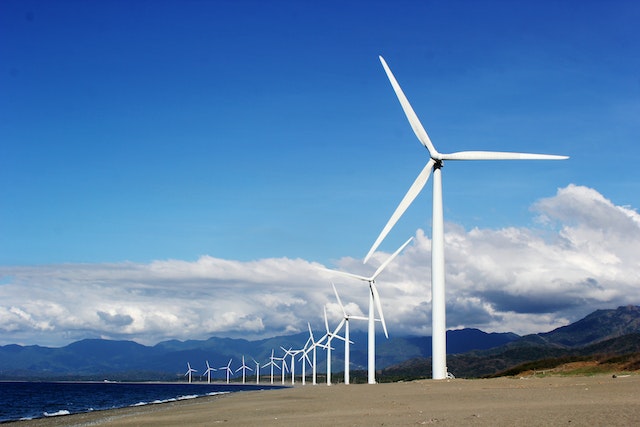
How much wind does a wind turbine need? A wind speed of roughly 11 km/h.
Wind power has been used for over 2000 years. The windmill was invented in the 7th century in Persia and wind power was harnessed to grind grain. The wind could do the work of a herd of oxen. Although oxen will work in any weather, a windmill needs wind. In 1887, James Blyth made a wind turbine that generated electricity. He used it to power the lights in his holiday home. The first wind turbine connected to a utility grid was made in 1951.
There are three types of wind turbine. The most common type are the big propellers on a pole. They are called Horizontal Axis Wind Turbines (HAWT). They have to be pointed into the wind or they won’t work. The second type are Vertical Access Wind Turbines (VAWT). They have curved vertical blades around a central pole. They don’t have to be angled into the wind, but they don’t produce as much energy as HAWT. The third type are also VAWT. They are Darrieus Wind Turbines, but they are known as eggbeaters because of their shape. They have vertical blades on a pole, but the blades are extended out from the pole on a wire frame. They are more efficient than other VAWT, but the blades cause a lot of stress on the pole.
Let’s concentrate on HAWT because they are the most common wind turbines. They have three blades that are made of carbon fiber. It is strong, light, and very durable. When the wind blows it contains kinetic energy and that energy makes the blades rotate. The propellers spin a shaft that rotates an electromagnet. This electromagnet spins inside a stationary magnetic field and this produces an electric current. The electricity travels down the column of the turbine and into the national grid. The wind doesn’t always blow and the wind turbine sometimes makes more and sometimes less electricity. When it produces too much, the excess is stored in a battery to be released later.
So, how much wind does a wind turbine need? That depends on the size of the turbine, but they will generally start spinning with a wind of 11 km/h. With wind slower than this, there isn’t enough energy to overcome the weight of the turbine blades. Some of the larger wind turbines have blades that are 47 m long and weigh 12,474 kg each. Three blades means the wind needs to move 37,422 kg. The blades are obviously optimized to catch as much wind as possible and the generator and all joints are lubricated to remove as much friction as possible.
Wind turbines have an upper wind limit as well. Most wind turbines are rated to about 88 km/h. If the wind gets stronger than this, there is the risk of damage, so the turbines contain a braking system to slow them down. Up to this point, the more wind a wind turbine can get, the better. The power that can be generated from wind increases with the cube of the wind speed. If the wind speed increase from 21 km/h to 25 km/h, the power produced increase by 60%. Every time the wind speed doubles, the amount of electricity produced goes up by 8 times. An average wind turbine can produce over 6 million kilowatt hours of electricity per year. The average American house uses 10,500 kilowatt hours per year, so a wind turbine can power 571 American houses.
Wind turbines are an excellent source of clean energy and they are becoming cheaper as the technology improves. Wind is a free resource, so anybody can use it. However, they have to be located in the correct place. They obviously require a constant flow of wind to generate power. They also needed to be angled into the flow of the wind. This means that a lot of analysis needs to be done before a wind turbine farm is built. The owners have to be confident they will get enough wind and in a constant direction. On the negative side, though, they can have an impact on wildlife in the area they are built in. They are also not a 100% reliable source of energy because sometimes the wind doesn’t blow. The goal of renewable energy is not to rely on one source but to combine different sources to create a reliable supply of power. This is slowly becoming a reality. Iceland currently produces 86.87% of its electricity from renewable sources and Norway is on 71.56%. There is no reason why all countries can’t get there as well. And this is what I learned today.
Photo by Kervin Edward Lara: https://www.pexels.com/photo/white-wind-turbines-on-gray-sand-near-body-of-water-3976320/
Sources
https://www.pbsnc.org/blogs/science/how-much-wind-does-a-wind-turbine-need/
https://en.wikipedia.org/wiki/Wind_turbine
https://www.nationalgrid.com/stories/energy-explained/how-does-wind-turbine-work
https://www.electricgeneratorsdirect.com/stories/1485-How-Generators-Work.html
https://www.takomabattery.com/the-role-of-wind-turbine-battery-and-faqs-guide/
https://www.compositesworld.com/articles/wind-turbine-blades-big-and-getting-bigger
https://www.eia.gov/tools/faqs/faq.php?id=97&t=3
